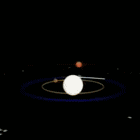 After the cancellation of the Centaur liquid-fueled propulsion module – considered too risky for use aboard the space shuttle, all aspects of which are now under a wide-ranging government review after the Challenger disaster – NASA/JPL’s Galileo Jupiter probe is to begin undergoing modifications for a long, looping trajectory developed by Dr. Roger Diehl and dubbed “VEEGA” – Venus/Earth/Earth Gravity Assist. (Another nickname for this new trajectory, the Solar Cruiser, doesn’t stick in acronym-happy NASA.) VEEGA will see Galileo taking an extra four years to reach Jupiter, getting gravity assists from the planets of the inner solar system during those additional years. Galileo must be modified because it was designed for outer solar system exploration, not exposure to solar heating and radiation within 1 AU of the sun. Since the primary high-gain antenna must be pointed away from Earth during some of this flight, NASA adds a medium-gain antenna to the spacecraft – a last-minute modification which will save the mission when the high-gain antenna fails to open on schedule. Galileo is scheduled for launch via space shuttle in 1989.
After the cancellation of the Centaur liquid-fueled propulsion module – considered too risky for use aboard the space shuttle, all aspects of which are now under a wide-ranging government review after the Challenger disaster – NASA/JPL’s Galileo Jupiter probe is to begin undergoing modifications for a long, looping trajectory developed by Dr. Roger Diehl and dubbed “VEEGA” – Venus/Earth/Earth Gravity Assist. (Another nickname for this new trajectory, the Solar Cruiser, doesn’t stick in acronym-happy NASA.) VEEGA will see Galileo taking an extra four years to reach Jupiter, getting gravity assists from the planets of the inner solar system during those additional years. Galileo must be modified because it was designed for outer solar system exploration, not exposure to solar heating and radiation within 1 AU of the sun. Since the primary high-gain antenna must be pointed away from Earth during some of this flight, NASA adds a medium-gain antenna to the spacecraft – a last-minute modification which will save the mission when the high-gain antenna fails to open on schedule. Galileo is scheduled for launch via space shuttle in 1989.
Tags:
Categories
Comments are closed